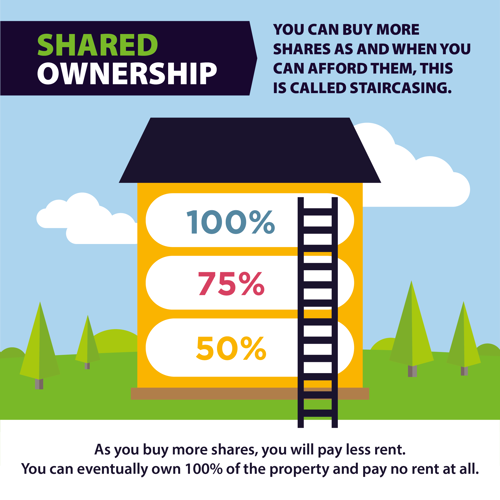Yes, staircasing shared ownership can be worth it. It allows you to increase your property stake.
This can lead to full ownership over time. Shared ownership offers a unique path to homeownership. It combines renting and owning, making it accessible for many. Staircasing lets you buy more shares of your property when you are ready. This can be a smart financial move.
It provides more control over your home and potentially increases your investment. But is it always the right choice? Considering costs, market trends, and personal goals is essential. Understanding staircasing can help you decide if it’s the right step for you. Let’s explore the benefits and challenges of staircasing shared ownership.

Shared Ownership Basics
Shared ownership helps people buy a home. You buy a part of the house. The rest is owned by a housing group. This means lower costs at first. You pay rent on the part you don’t own. Many people find this helpful.
Buying more shares is called staircasing. You own more of the house. This can lower rent. Full ownership is possible this way. But there are costs. Legal fees and valuations are needed. Not everyone can afford this. Some homes may not allow full staircasing. Understanding both sides is important.
Staircasing Explained
Staircasing lets you buy more of your home. It means owning a bigger share. You start with a small share. Over time, you buy more. This increases your ownership. You can buy in stages. Each stage is called staircasing.
You must meet certain rules. Eligibility Criteria is important. You need to check your contract. It shows your staircasing options. Some homes have limits. You may need a certain income. Savings are often needed. Check with your housing provider. They guide you through the process.
Financial Considerations
Staircasing shared ownership can be costly. You need to pay for a valuation. The valuation tells how much your share is worth. Legal fees are also involved. These fees cover the paperwork. Stamp duty might be needed too. It depends on the share size. Mortgage arrangement fees may apply. These fees are for loan changes. Be sure to check all costs first. Planning helps avoid surprises.
Different funding options exist for staircasing. Savings can be one choice. Using savings means no extra debt. Another way is a mortgage. This requires approval from the lender. You can also look at shared ownership schemes. These schemes might offer help. Some people use family loans. This is borrowing from family or friends. Always check terms before deciding. Being informed helps make better choices.
Market Conditions Impact
The housing market can change often. Prices might go up or down. People look at these trends to make decisions. Staircasing means owning more of your home. When prices rise, homes cost more. It might be harder to staircase. If prices drop, staircasing could be easier.
Interest rates affect home buying. They can change a lot. Low rates mean people pay less for loans. This might help when staircasing. High rates can make loans cost more. People have to think about these rates. It helps them plan better. Staircasing can be good or bad with changing rates.
Legal Implications
Staircasing shared ownership means buying more of your home. This can change your contractual obligations. You might need to follow new rules. The contract might have strict terms. You must read it carefully. Understand what changes when you buy more shares. This can affect your monthly payments. Always check for any hidden fees. It’s important to know your rights. Talk to a legal expert if unsure. They can explain the details. Make sure you are comfortable with the changes.
Buying more of your home can affect your tax situation. You might need to pay more tax. This depends on your new share percentage. Check if you need to pay stamp duty. Larger shares might mean higher taxes. Keep track of all payments and dates. You should know if there are any tax breaks. Some areas offer tax relief for homeowners. Always ask a tax expert for advice. They can help you plan better. This ensures no surprise bills later.
Pros And Cons Of Staircasing
Staircasing in shared ownership allows buying more property shares, increasing ownership but raising expenses. Benefits include more equity and potential profit; drawbacks involve higher costs and financial commitment. Carefully consider financial stability and future plans before deciding.
Advantages
Staircasing lets you buy more of your home. You can own a bigger share, which means fewer rent payments. Building equity can make you feel more secure. Your home might increase in value over time. It can be a smart way to invest money. Owning more can give you more control over decisions. You might even save money long-term.
Potential Risks
Costs can be high when staircasing. Fees and charges can add up. House prices might fall, making it risky. You might not get back all your money. Selling your home can become harder. You might need a bigger mortgage. More stress and paperwork can be involved. Think carefully before deciding.
Maximizing Equity Benefits
Buying more shares in a shared ownership home can be smart. Over time, your equity grows. This means you own more of your home. Long-term financial gains come from owning more. As you own more, your expenses could be lower. You might pay less rent. This helps save money over time.
Investment strategies are important. Think about your budget. Plan how much you can buy. It might be best to buy shares slowly. Small steps can lead to big gains. Owning more shares gives you more choices. You might sell your home for more money. Or you could keep it as a valuable asset.
Decision-making Process
Think about your future plans. Do you wish to own more of your home? Staircasing can help increase your share in the property. This means you will own a bigger part of your house. Consider if you can afford more payments. Owning more can feel good. It can also bring more responsibilities. Make sure your goals align with this choice.
Talk to people who know a lot about homes. Experts can give you advice. They can help you understand the process better. They explain costs and benefits. These people know about money and homes. They can help you make smart choices. It’s always good to ask for help when unsure. Experts can guide you well.

Frequently Asked Questions
What Are The Downsides Of Shared Ownership?
Shared Ownership can lead to high service charges and limited property control. Selling your share might be difficult. You may also face restrictions on making property alterations, and staircasing costs can be high. There’s also the risk of property value depreciation, impacting your investment.
Can You Pay Off Shared Ownership?
Yes, you can pay off Shared Ownership through a process called “staircasing. ” Buy additional shares to eventually own 100% of the property. Consult your housing provider for specific terms and conditions. Owning the entire property may increase your mortgage but eliminates rent payments.
What Is The Best Percentage For Shared Ownership?
The best percentage for Shared Ownership typically ranges from 25% to 75%. This range allows flexibility based on individual financial situations and goals. It’s crucial to assess your affordability and long-term plans before deciding. Consulting with a financial advisor can help determine the most suitable percentage for your needs.
What Is A Shared Ownership Home With Option To Staircase?
A Shared Ownership home allows you to buy a portion and pay rent on the rest. Staircasing is the process of gradually buying more shares to eventually own the property fully. This option provides a flexible and affordable way to step onto the property ladder and increase ownership over time.
Conclusion
Staircasing shared ownership can be a beneficial choice. It depends on your financial situation and long-term goals. Owning more of your home can increase security. It may also boost your property’s value. But, consider the costs involved. Legal fees and valuation charges can add up.
Evaluate your budget carefully. Research the market and seek professional advice. This helps make an informed decision. Remember, every homeowner’s situation is unique. Weighing the pros and cons is essential. Make the choice that best suits your future plans.
